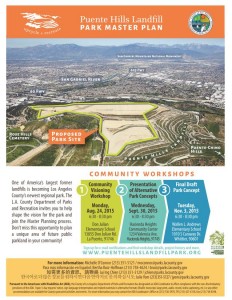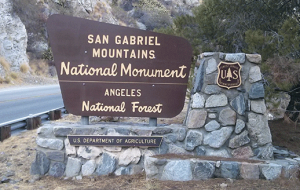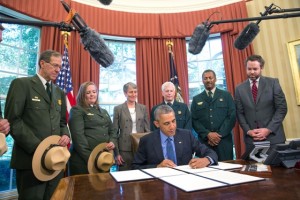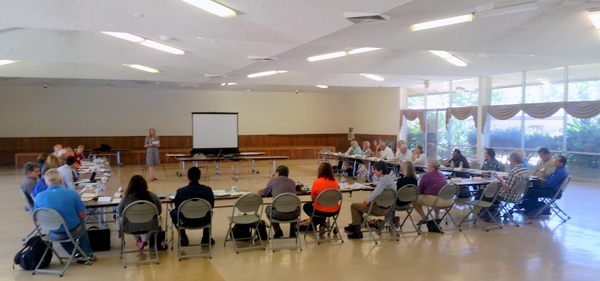On a beautiful day for riding in Malibu Creek State Park, there were 16 at the free Basic Skills Clinic, which is always held the first Saturday of the month. You can see the photos in our August photo gallery.
Archive for the ‘Regions’ Category
August 2015 Skills Clinic Photos Posted August 2nd
Sunday, August 2nd, 2015Puente Hills Landfill Park Master Plan Announced
Tuesday, July 28th, 2015 The decommissioned Puente Hills Landfill is preparing to become the newest addition to the Los Angeles County regional park system. The area has outlived it’s usefulness as a landfill, and is presently a blank canvas waiting for a public park to be developed. The proposed park is close to Chino Hillls, Turnbull Canyon and the Emerald Necklace, all areas popular for outdoor recreation, including cycling and mountain biking.
The decommissioned Puente Hills Landfill is preparing to become the newest addition to the Los Angeles County regional park system. The area has outlived it’s usefulness as a landfill, and is presently a blank canvas waiting for a public park to be developed. The proposed park is close to Chino Hillls, Turnbull Canyon and the Emerald Necklace, all areas popular for outdoor recreation, including cycling and mountain biking.
There are a there meetings scheduled:
Community Visioning Workshop, Monday, August 24, 2015, 6:30 – 8:30 and the Don Julian Elementary School, 13855 Don Julian Road, La Puente, 91746
Presentation of Alternative Park Concepts, Wednesday, September 30, 2015, 6:30 – 8:30, Hacienda Heights Community Center, 1234 Valencia Ave, Hacienda Heights, 91745
Final Draft Park Concept, Tuesday, November 3, 2015, 6:30 – 8:30, Wallen L. Andrews Elementary School, 1010 S Caraway Drive, Whittier, 90601.
We invite mountain bikers and CORBA members to attend one or more of these meetings. The more the County hears demands for Bike Park facilities in the Los Angeles, the more likely we will be to get one. Whatever park ideas people have can to be presented and discussed at the initial meetings or by contacting moconnor@parks.lacounty.gov.
More information can be found at www.PuenteHillsLandfillPark.org.
President declares three new National Monuments
Saturday, July 11th, 2015Yesterday, July 10, 2015, President Obama used his powers under the Antiquities act to declare three new National Monuments. There were another three declared in February 2015, and a further monument in December. That’s seven new National Monuments since we were given the San Gabriel Mountains National Monument on October 10, 2014.
Clearly, this President has been on a roll when it comes to land protections. All of these new National Monuments will face the similar challenges of developing management plans that protect the resources of the monuments, but also allows for recreation and enjoyment of those resources. Each has their unique characteristics and each proclamation is written specifically for each monument.
Of the most recently-declared monuments, one has no real biking opportunities. The Waco Mammoth National Monument was owned and operated as an archaeological dig site by the City of Waco, Texas. Under the new monument, the city of Waco will transfer the 108 acre site to the Federal Government, via the National Park Service, who will now coordinate with the City and with Baylor University to continue archaeological research and protect the site.
The other two, Berryessa Snow National Monument in northern California, and the Basin Range National Monument in Nevada, both include trails and mountain biking opportunities on a mix of Forest Service and BLM lands. In both proclamations, recreation opportunities are considered. The Berryessa Snow proclamation reads “…motorized and mechanized vehicle use in the monument shall be allowed only on roads and trails designated for such use, consistent with the care and management of the objects identified above.”
In the Basin Range, more than 700,000 acres of Nevada desert and mountain terrain, there are many trails. The proclamation similarly states that “…motorized vehicle use shall be permitted only on roads existing as of the date of the proclamation. Non-motorized mechanized vehicle use shall be permitted only on roads and trails designated for their use, consistent with the care and management of the objects identified above. The Secretary shall prepare a transportation plan that designates the roads and trails where motorized or non-motorized mechanized vehicle use will be permitted.”
In both of the above examples, just as in our own San Gabriel Mountains National Monument, mountain bikes will be permitted only on roads and trails authorized for their use. One difference between the two, however, is that the Basin Range proclamation also explicitly prohibits the development of new motorized vehicle routes. No such restriction is placed on non-motorized trails used for mountain bikes or “mechanized” travel, but the development of a transportation plan is where the details will be hammered out.
Similarly, our San Gabriel Mountains National Monument allows existing uses on existing trails, but also calls for the development of a transportation plan that will include trails, roads, and their respective use designations. Mountain bikers in all these areas should be thankful for the elevated protections these special places have now been given, but should also remain engaged as active trail advocates, trail stewards, and partners in the development of the management plans and transportation plans that will govern our future access to and enjoyment of these special landscapes and the trails by which we experience them.
July 2015 Skills Clinic Photos Posted July 4th
Saturday, July 4th, 2015On a beautiful day for riding in Malibu Creek State Park, there were 15 at the free Basic Skills Clinic, which is always held the first Saturday of the month. You can see the photos in our July photo gallery.
Bike Thefts On The Rise–Again
Friday, July 3rd, 2015Evidently there has been a rash of bicycle thefts that have hit several CORBA members within the last month. While it is not known if the perpetrators are part of an organized ring, LAPD officer John “Rusty” Redican thinks it sounds a lot like a gang that was operating out of South Los Angels a few years ago. Click here for the link to MTBR to view his post and see photos of the thieves that were arrested a few years back. Below is the text of his post:
Hello All, My name is John (Rusty) Redican, I’m a fellow cyclist and LAPDOfficer. This reminder is not an official LAPD news blast, but me as a fellow cyclist and community member arming you with a little information to keep you and your property safe. Due to another salient event, where a fellow cyclist had his bicycles stolen out of his garage.
I need to advise you all about a ring of high end bicycle thieves that we (LAPDWest LA Division) arrested a couple years back, who may or may not be at it again. That arrest was only made possible due to cooperation between the cycling community and the police. First off, be very cautious on what you post on social media, i.e. Facebook, Instagram, Strava and similar forms of tracking and communication we all use for our shared love of cycling.
A few years back, this ring of bike thieves, based out of south Los Angeles, were responsible for millions of dollars of bicycle thefts, from San Diego County to Ventura County. They would follow cyclists home from group rides, scour FaceBook and other social media for intel on cyclists and their homes, so they could conduct surveillance on you and break into your garage or storage areas to steal your bicycles. They would do this during the day mostly when no one was home, but also at night while you slept. At times they would cause damage to the garage, but most times they were very surreptitious about it and the only evidence left, was the absence of your property. The majority of the bikes they targeted were well worth (as you all know) the chance for them to get caught by the home owner. At the time, they used a very clean and newer model silver, 4 door Audi sedan with bike racks on it. The suspects in the cases I’m referring too were all male hispanics in their mid to lat 20’s – early thirties, between 5’6” and 5’9”, 175 lbs to 220 lbs, not climbers. Again, I’m not saying this is definitely them, but the MO used in the theft of bikes from one of our fellow cyclists in Torrence, last week is very similar.
So be advised and be cautious of what you put on social media, NEVER have the starting point to your ride be your residence, and be cautious on who you share your photos and information with. Also, you don’t have to be paranoid, but be aware of your surroundings and if you notice a vehicle following you, or the same vehicle in 3 different locations, that may be a clue, and take not of the lic plate number, or any other distinguishing characteristics of the vehicle and occupant(s). Criminals are not dumb, and have evolved with the technology, so a little operational security will help you keep your property that you love, and work hard to obtain. If you see anything suspicious please be a good witness, don’t physically get involved, as you never know what these criminals are armed with, but immediately call your local police department.
Anyway, I put this info out not to alarm, but to inform, for-warned is for-armed. Please share with your cycling teams and groups, or any cycling friends who may benefit from this information.
These are the suspects from 2012. This photo is from CBS Los Angeles. They were apparently seen today in Corona at Corona High checking out the mountain bike teams bikes and asking questions… They are now driving a black newer model Honda Accord….FYI…
TO Acorn Publishes Article on Trail Conflict, Etiquette
Thursday, July 2nd, 2015An evenhanded account of the issues surrounding conflict and etiquette on the trails was published on the front page of the July 25th issue of the Thousand Oaks Acorn.
The article starts with an account by an equestrian in Ahmanson Ranch who felt threatened by mountain bikers who sped by and shouted expletives when asked to slow down. The equestrian also has been charged by unleashed dogs on other outings.
Mark Langton, CORBA board member and past president, is quoted extensively on the need for mountain bikers to show speed restraint when passing other people on the trail.
Another cyclists is critical of people who take poorly trained horses on trails where they can expect to encounter mountain bikers.
An equestrian from Agoura Hills says the vast majority of mountain bikers show appropriate courtesy. “This is pretty much a nonissue with all but a tiny handful of jerks on bicycles and nervous equestrians who are afraid of their horses and probably should not be on the trails in the first place.”
Finally, there are some quotes from representatives of the Santa Monica Mountains National Recreation Area, including Superintendent David Szymanski.
You can read the full article here.
President’s Message: It’s complicated
Thursday, July 2nd, 2015There’s always a lot going on here in Southern California. We have recently submitted comments on the Rim of the Valley study. We’re expecting the Santa Monica Mountains NRA Interagency Trail Management Plan early next year. A new National Monument management plan development process just began, though CORBA has been involved in the Community Collaborative Group since last November. We’ve successfully alerted L.A. County of the need for another trail master plan, to be announced soon. We have pending Bike Park proposals, and a recently-opened Bike Park in Fillmore. We have a growing high school and middle school racing contingent. We have a new Forest Supervisor. There are wilderness proposals, missing links in trails, fire-damaged trails still in need of restoration, access issues on Etz Meloy (Backbone Trail). There’s no shortage of issues, threats to our public lands, our trails and access to them.
It’s complicated.
And it takes time to figure things out and try to get things right. These studies and plans seem to disappear from the radar, only to re-emerge six months to a decade later. Advocacy is a marathon, not a sprint, and CORBA is still at it after 28 years. Government is slow to move but no matter how frustratingly slow it sometimes seems, there is progress being made.
CORBA is busily engaged in all of these processes on your behalf, in partnership with IMBA, to help make sure there is progress. We continue to work to make sure the landscapes we ride and the trails we love are protected, improved, and remain open to our community.
We need each and every one of you to be engaged as well. After all, we’re all ambassadors of the sport when we’re on multi-use trails. This means ride an appropriate speed for your sightline (slow down!) and be courteous. Be safe. Follow trail etiquette best practices. Be an example for others. Leave no trace. Support CORBA. Sign a petition. There are lots of ways to have a positive impact.
Riding trails to explore our public lands is a passion we all share, and want to continue to enjoy. Enjoy your summer and keep on riding!
Rim of the Valley Corridor Study
Tuesday, June 30th, 2015 CORBA has been involved in the Rim of the Valley Corridor since our inception. In fact, we’re so ingrained in the process that the Rim of the Valley Corridor is mentioned in our mission statement as our primary territory of concern. We were excited to see the draft study released, and have submitted comments on the plan.
CORBA has been involved in the Rim of the Valley Corridor since our inception. In fact, we’re so ingrained in the process that the Rim of the Valley Corridor is mentioned in our mission statement as our primary territory of concern. We were excited to see the draft study released, and have submitted comments on the plan.
The study sought to answer the following:
1. Does the area possess nationally significant natural or cultural resources?
2. Is it a suitable and unique addition to the National Park System?
3. Can it be feasibly added to the Park System?
4. Does it require direct NPS management, instead of stewardship from other groups or a public-private combination?
The answer to all of the above questions was a “yes.” The National Park Service presented four alternatives based on the study findings. The first NEPA-required “no action” alternatives serves as a baseline against which we can compare the alternatives. Alternative B allows the NPS to offer “technical assistance” to existing land managers within the study area, but falls short of allowing the NPS to make any direct capitol investments.
Alternatives C and D expand the authorized boundary of the Santa Monica Mountains National Recreation Area. What the boundary expansions really mean is that the National Park Service will be authorized to offer technical assistance to existing land managers for any project that enhances recreation, or restores habitat and connectivity. Under Alternative C or D, the NPS is also authorized to spend money on capitol projects within the expanded boundaries.
We believe that the largest operational boundary proposed under Alternative D would have the greatest long-term benefit for recreation, bio-connectivity, wildlife and the communities adjacent to the study area. It also includes the wildlife corridors linking the two areas of the Angeles National Forest separated by Highway 14, as well as between the Santa Susana Mountains and Los Padres National Forests.
The boundary expansion does not come without concern. The NPS, like most public land agencies, is currently under-funded. We would hope that any boundary expansion would come with an increase in funding sufficient to at least maintain the current level of service across the expanded NRA.
During the course of the public meetings we heard a lot of misinformation and a misunderstanding of what the boundary expansions mean. The Federal government will not be taking anyone’s property against their will. Existing land ownership rights and management authority is respected and maintained.
One thing that would change is the permitting of landfills. In our comments, we asked for the existing landfills to be excluded from the proposed NRA expansion to eliminate the need for additional permitting. We also feel that the recently completed San Gabriel Watershed and Special Resource Study which proposed a San Gabriel Unit of the NRA, must be considered and its findings also addressed by any congressional action to the effect of either.
The Rim of the Valley trail system is also important to us. It’s a proposed multi-use trail network that will encircle the San Fernando Valley, and perhaps Simi and Conejo Valleys. We feel the National Park Service will be in a good position to help facilitate its completion under Alternatives C or D.
It will probably be another year before we see a final recommendation from the study. From there it will be up to Congress to decide what to do with the recommendations.
2015-06-24 – Rim of the Valley Draft Study Comments from CORBA
June 2015 Skills Clinic Photos Posted June 10th
Wednesday, June 10th, 2015On a beautiful warm day for riding in Malibu Creek State Park, there was about a dozen at the free Basic Skills Clinic, which is always held the first Saturday of the month. You can see the photos in our June photo gallery. Neither Steve nor Graham was available, so Ezra did double duty as Mark’s assistant and photographer, too.
San Gabriel Mountain NM – Public Meetings June 22-27.
Friday, June 5th, 2015 At our last San Gabriel Mountains National Monument (SGMNM) Community Collaborative (the Collaborative) meeting, we learned the dates of the first round of public scoping meetings for the new Monument Management Plan.
At our last San Gabriel Mountains National Monument (SGMNM) Community Collaborative (the Collaborative) meeting, we learned the dates of the first round of public scoping meetings for the new Monument Management Plan.
President Obama gave the Forest Service three years to develop a management plan for the monument. The first step in that process is reviewing the current Angeles National Forest Management Plan, and the Presidential proclamation declaring the moment. They need to determine what needs to change in the current management plan to bring it into compliance with the proclamation and the new Monument.
The Forest Service will continue to manage the same land that was the Angeles National Forest as the SGMNM. This means they don’t need to write a new plan for the Monument. Instead They will be developing an amendment to the current management plan.
At this series of public meetings the Forest Service will present a “need to change” document: what they have so far determined needs to change in the current plan. They will be seeking public input on what they have found, and looking for public comments. Comments could be supportive, suggestive of improvements or object to the findings.
Comments will be taken at the meetings. The deadline for comments will end 45 days after this “need for change” document is released, which is expected mid-June). We understand the document is not long, expected between 10 and 20 pages long. The meetings will be four hours long, with stations explaining each aspect of the proposed changes. People can arrive at any time during the four hour window to review the materials. They will also be made available online at http://www.fs.fed.us/nepa/nepa_project_exp.php?project=46964.
While we don’t expect any surprises that will affect trail access for mountain bikers or other user groups. We may see changes in management structure, projects, funding and staffing levels, community involvement and access, and other things that we must consider. Until the document is released to the public we won’t know exactly what it contains.
Watch for CORBA’s reports and alerts, CORBA’s comments, and suggested comments for our members, will be posted after the first meeting. Please attend if you’re able, or visit the Forest Service planning web site at: http://www.fs.fed.us/nepa/nepa_project_exp.php?project=46964 to keep updated.
Meeting Schedule – Save the Dates
June 22, 4-8 p.m. – Pacific Community Center, 501 S. Pacific Ave, Glendale California
June 23, 4-8 p.m. – Palmdale Legacy Commons Senior Center, 930 East Ave Q9, Palmdale, California
June 24, 4-8 p.m. – Glendora Public Library, 140 S. Glendora Ave, Glendlora, California
June 25, 3-8 p.m. – Pico House, 424 N. Main Street Los Angeles, California
June 26 4-8 p.m. – Big Pines Lodge, 24537 Big Pines Highway, Wrightwood, California





